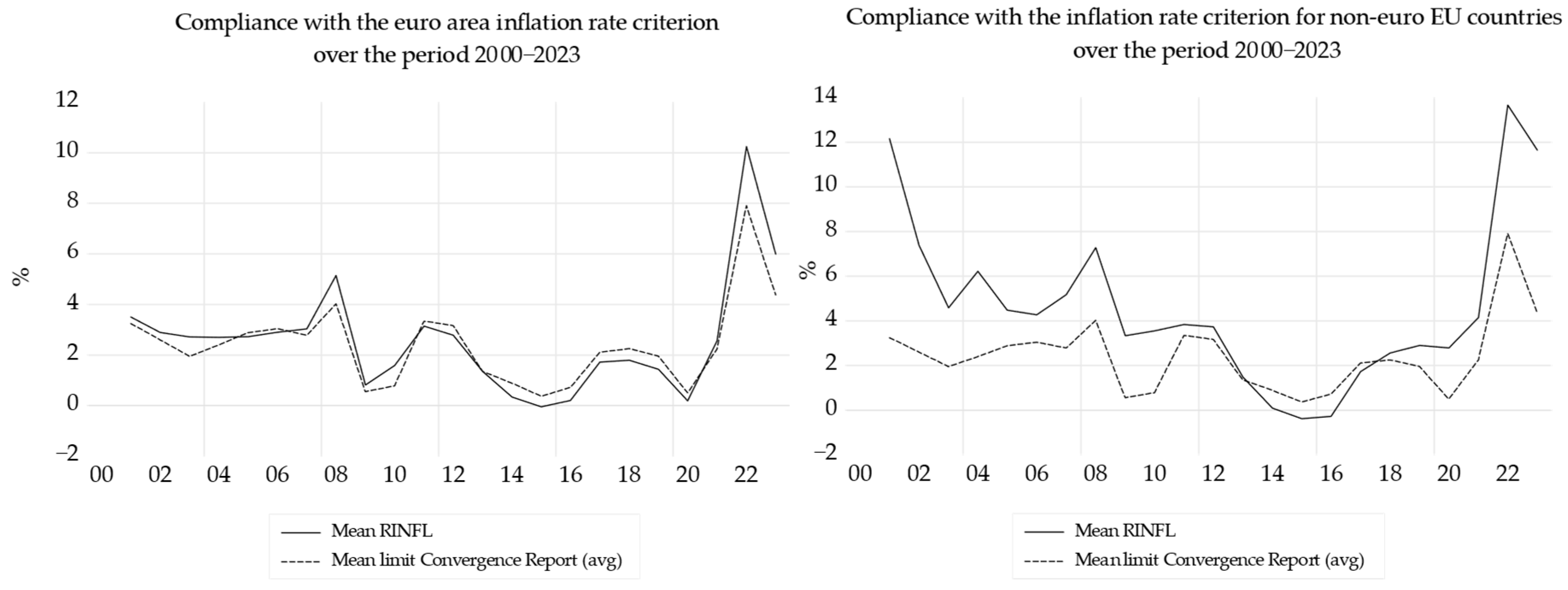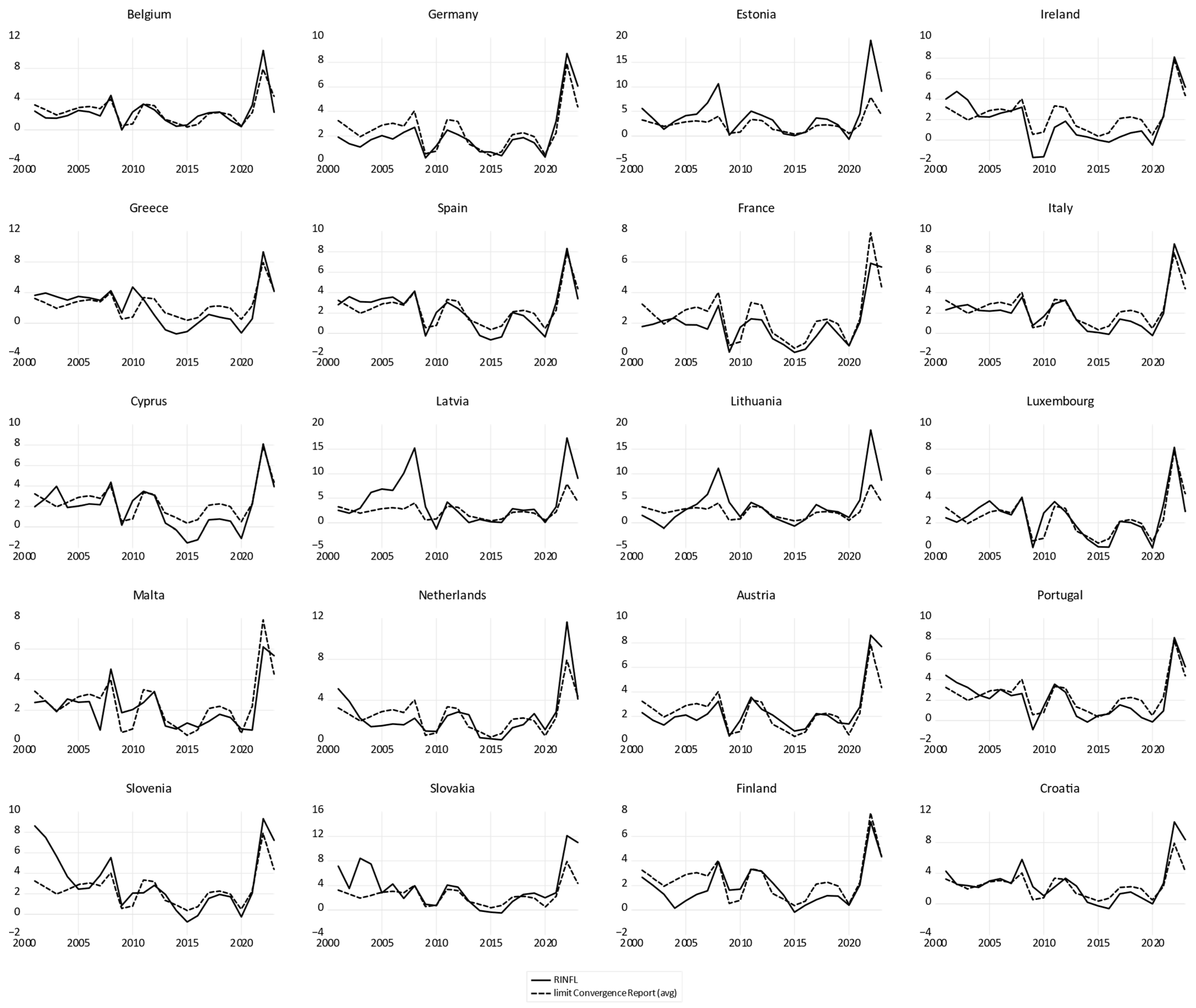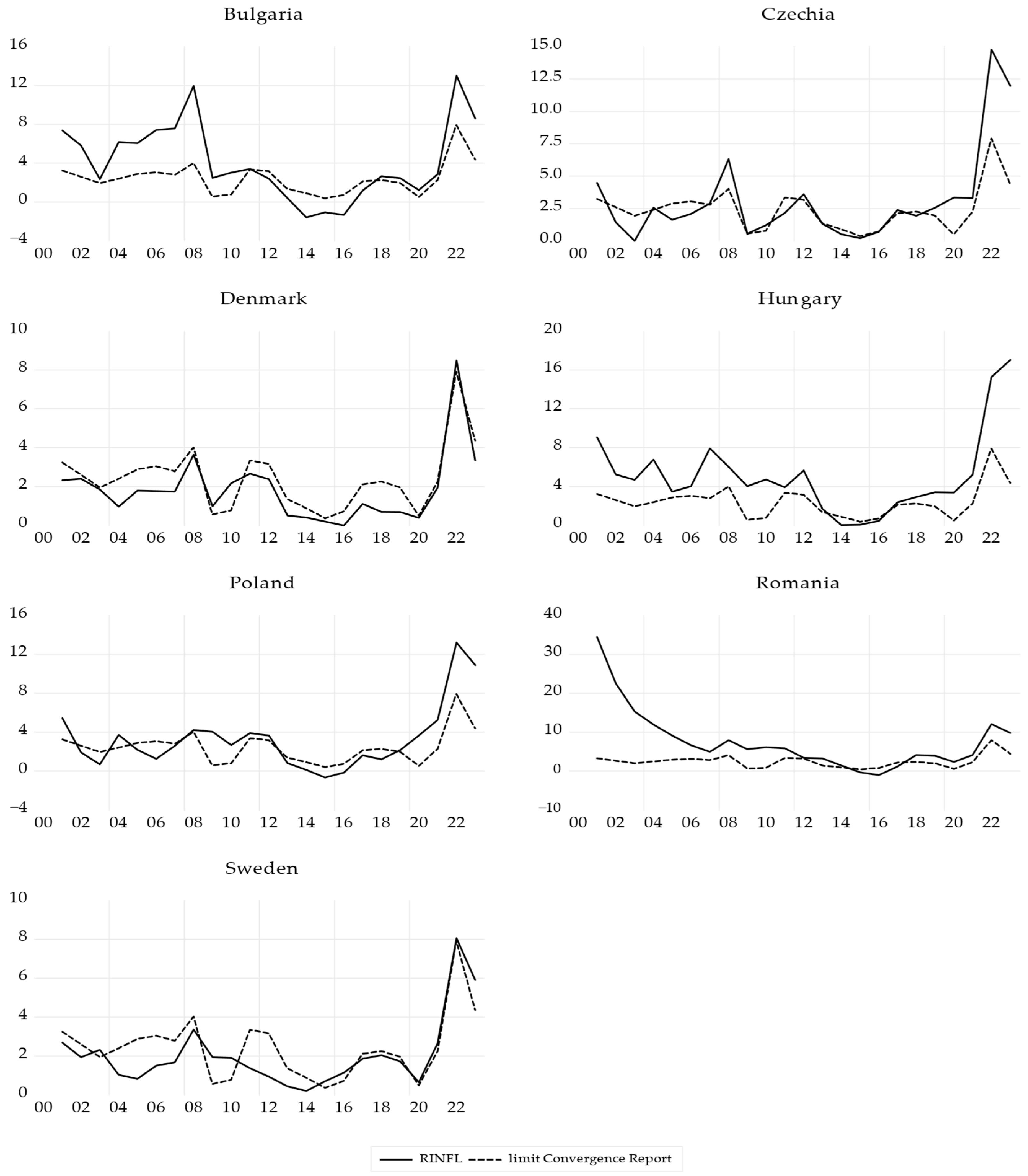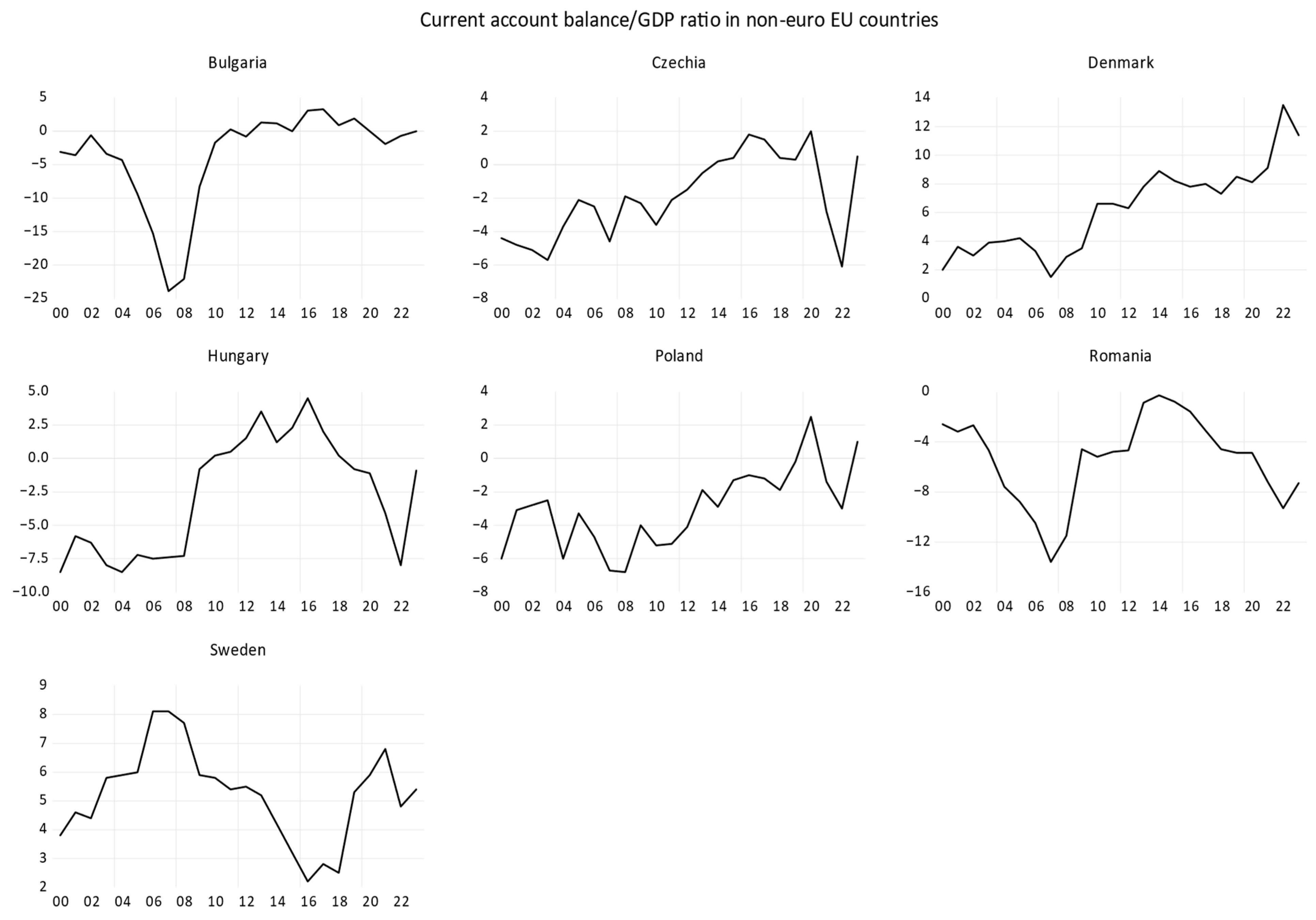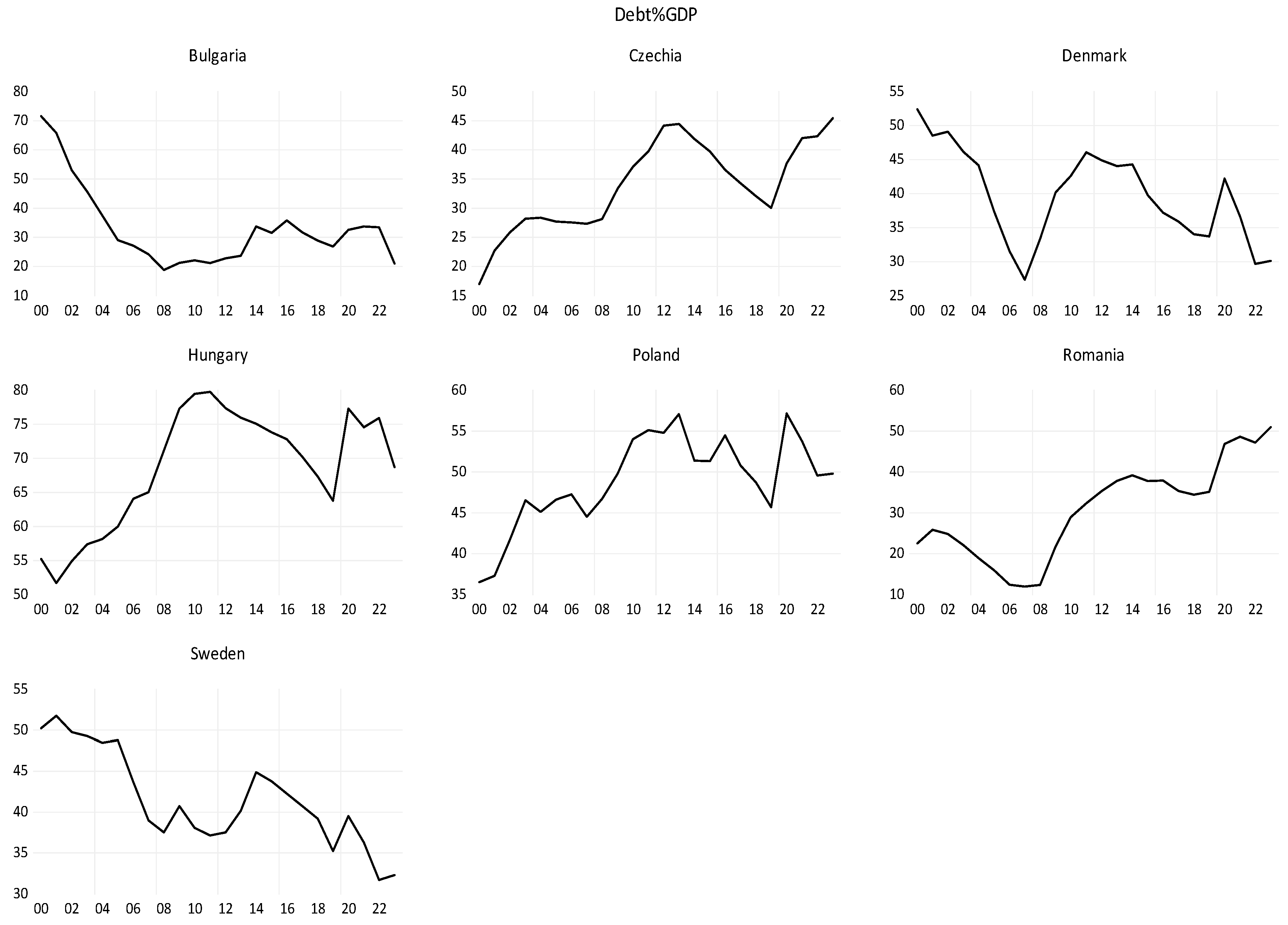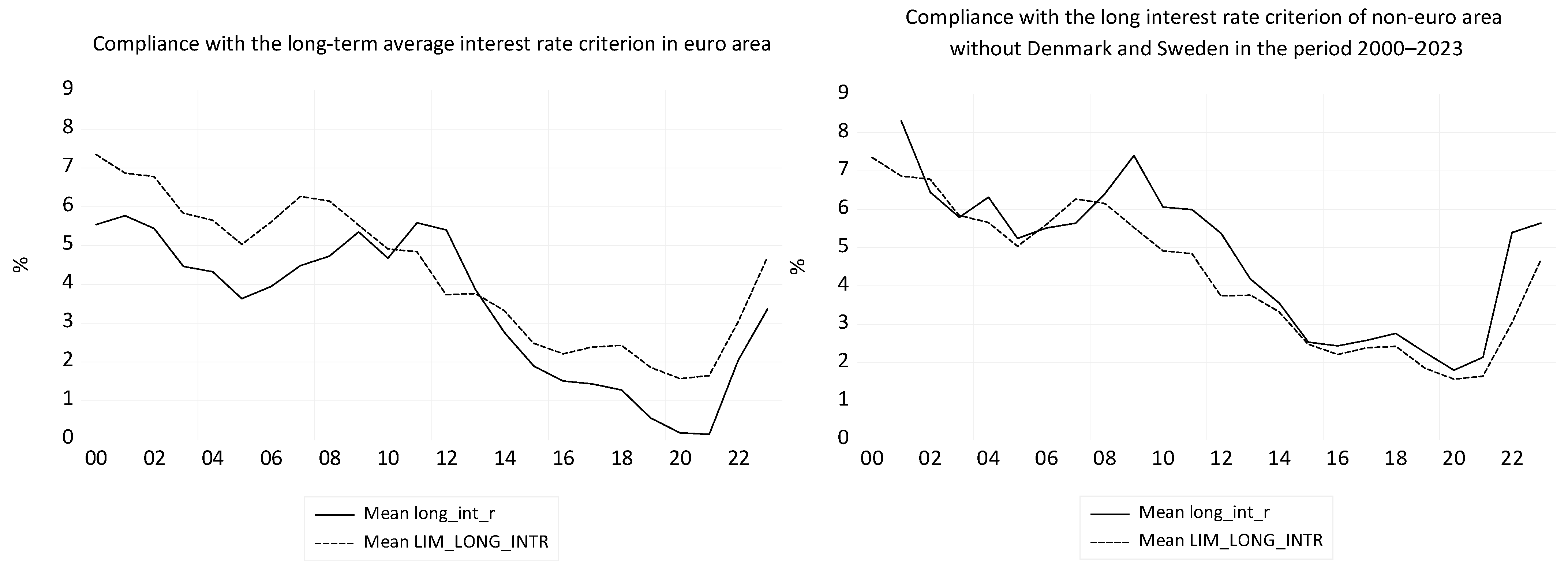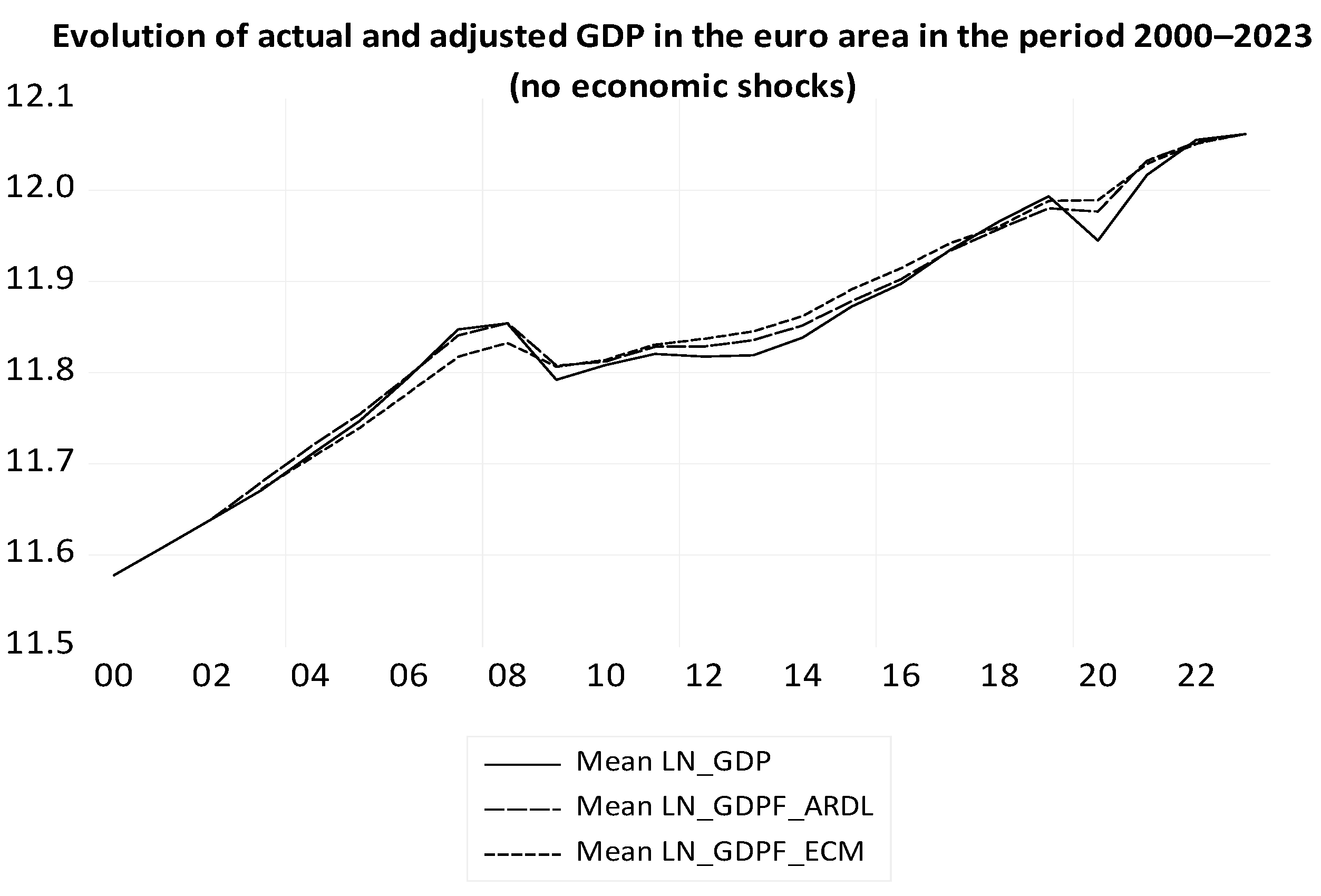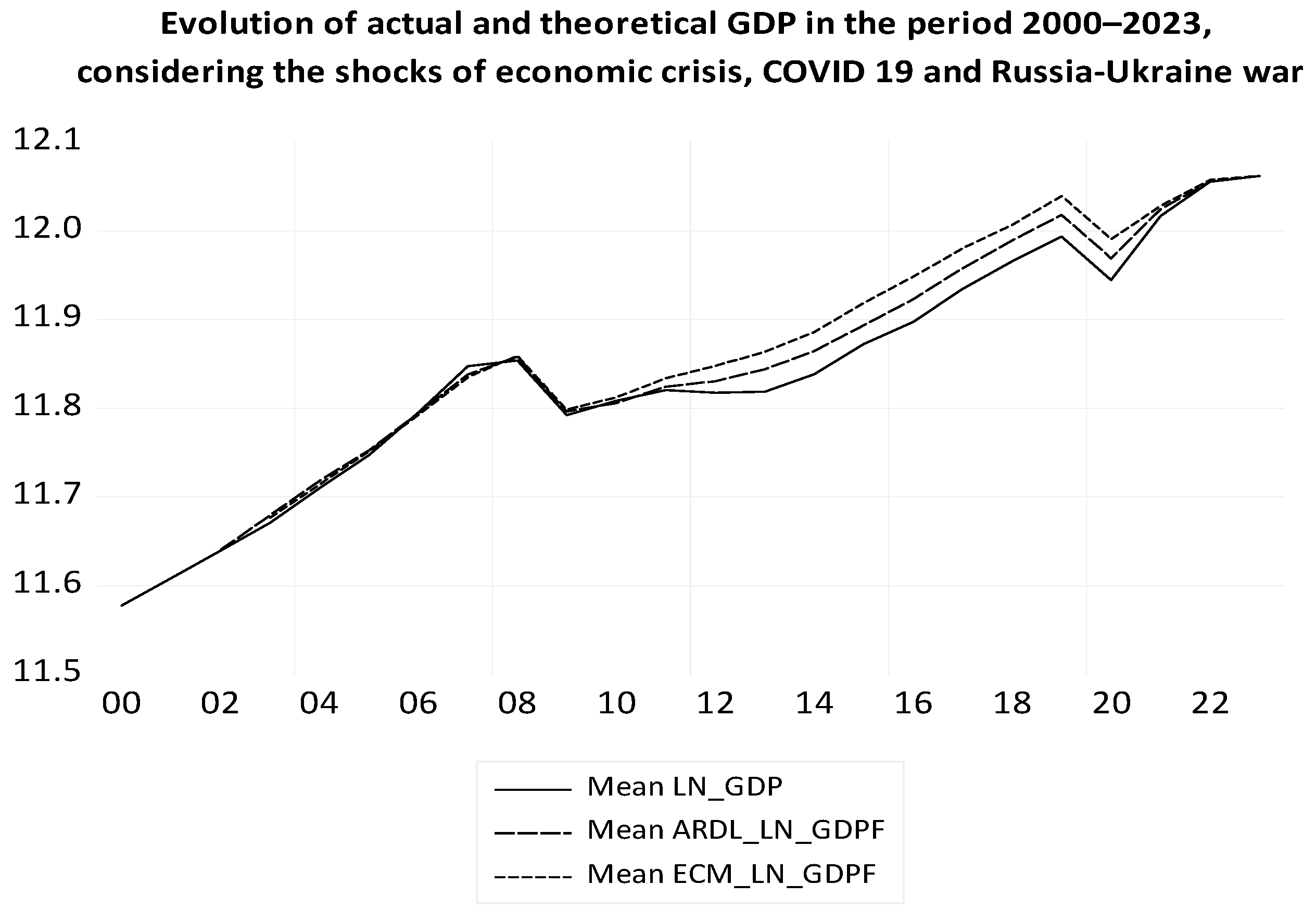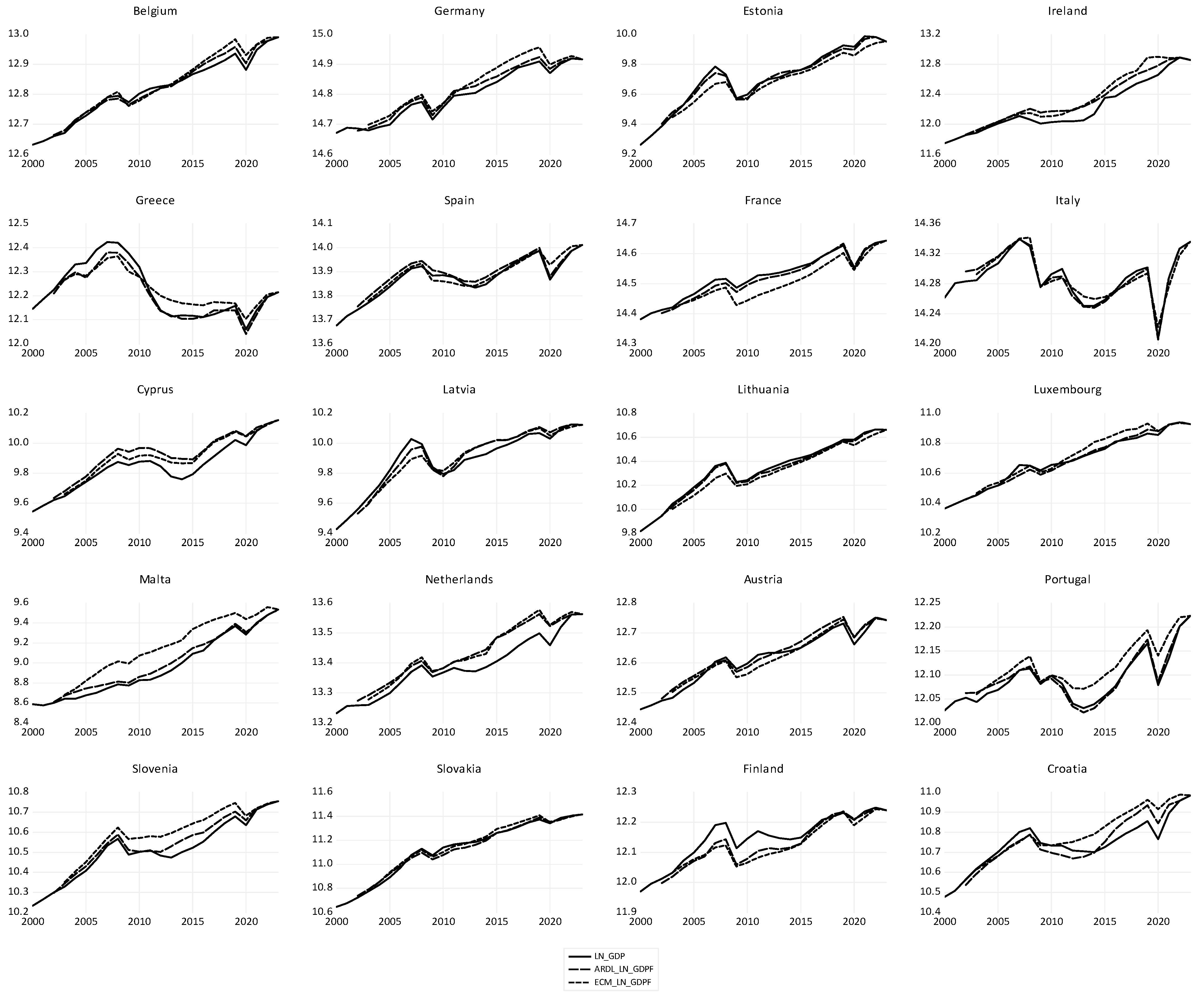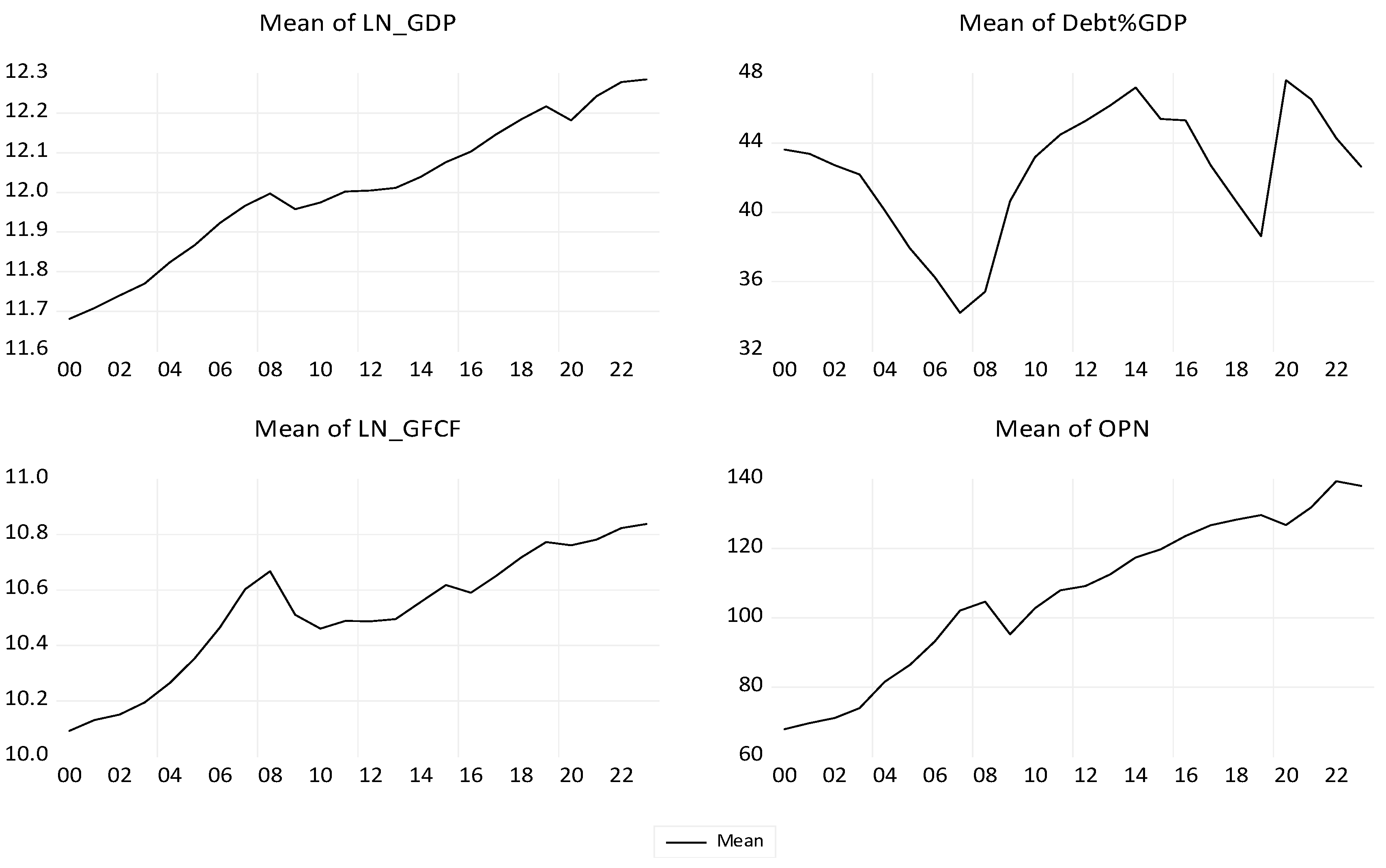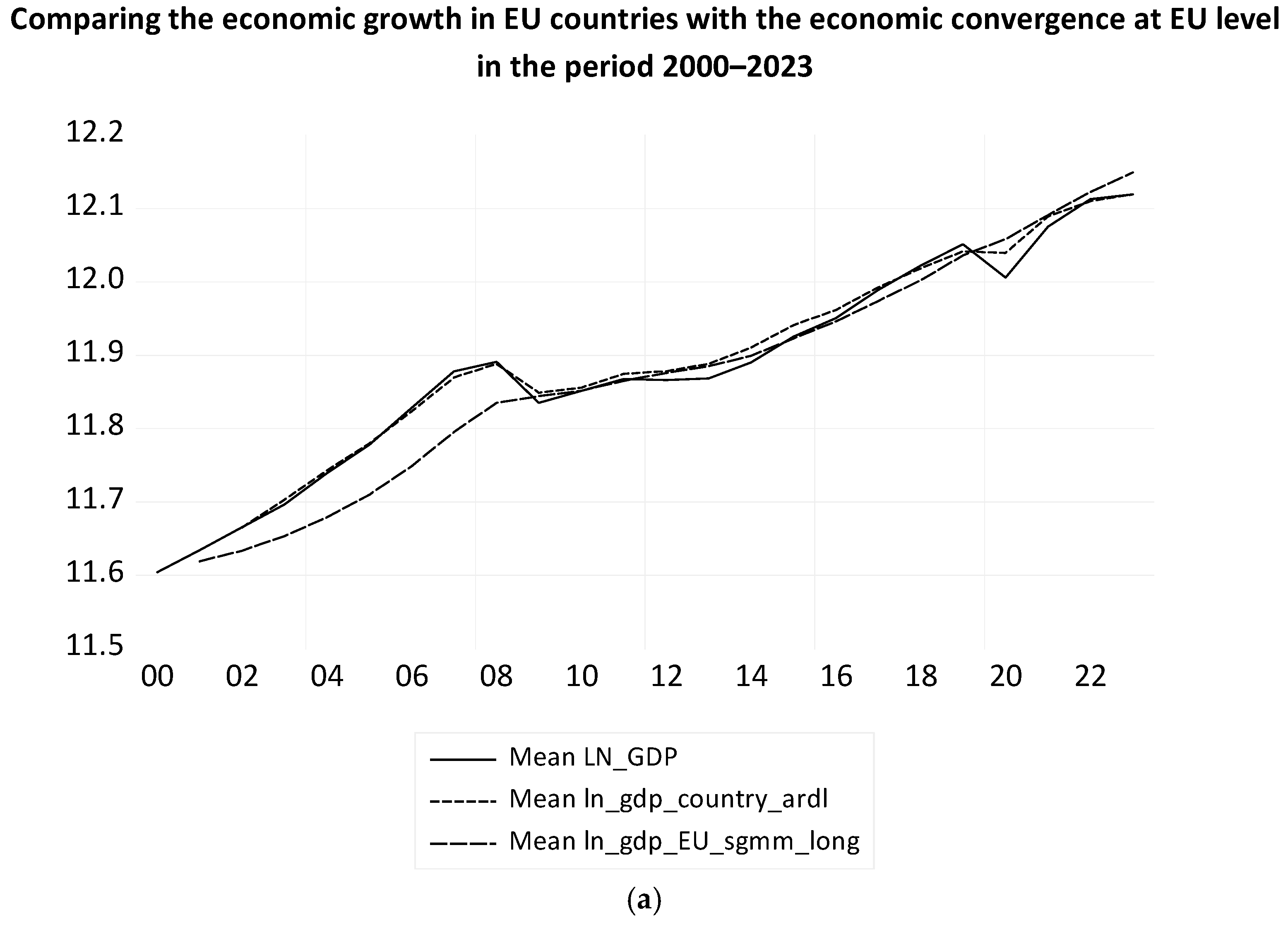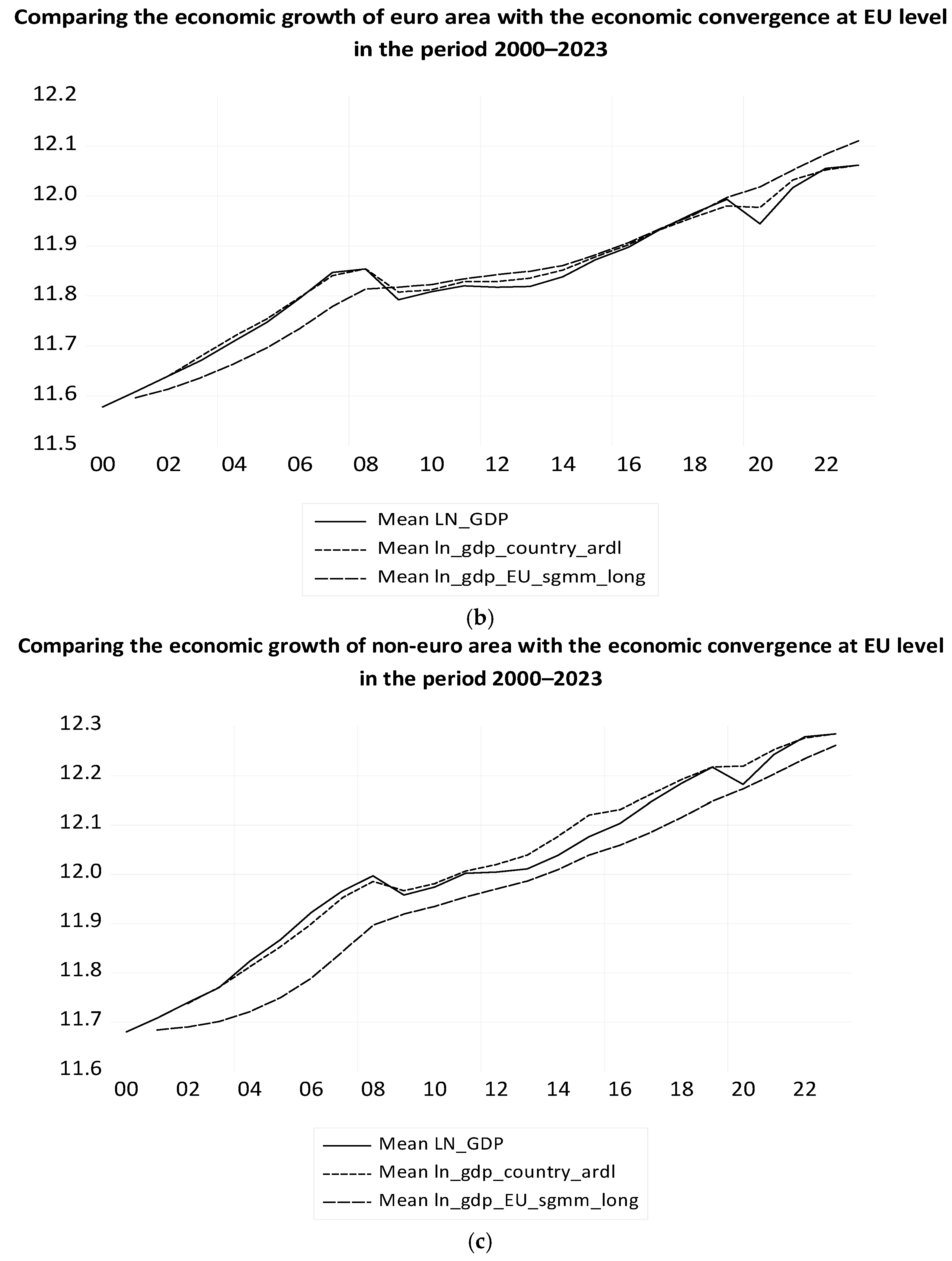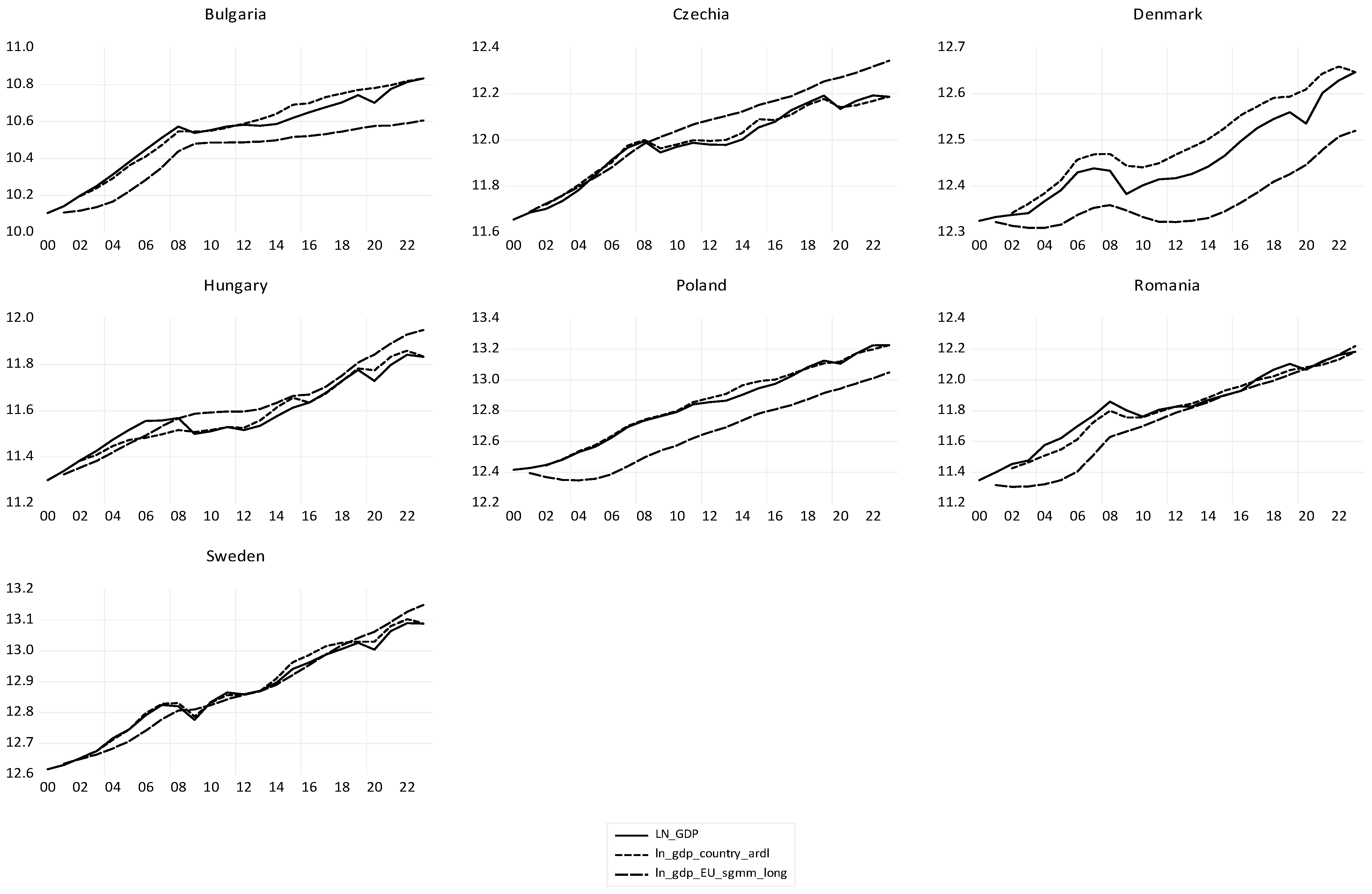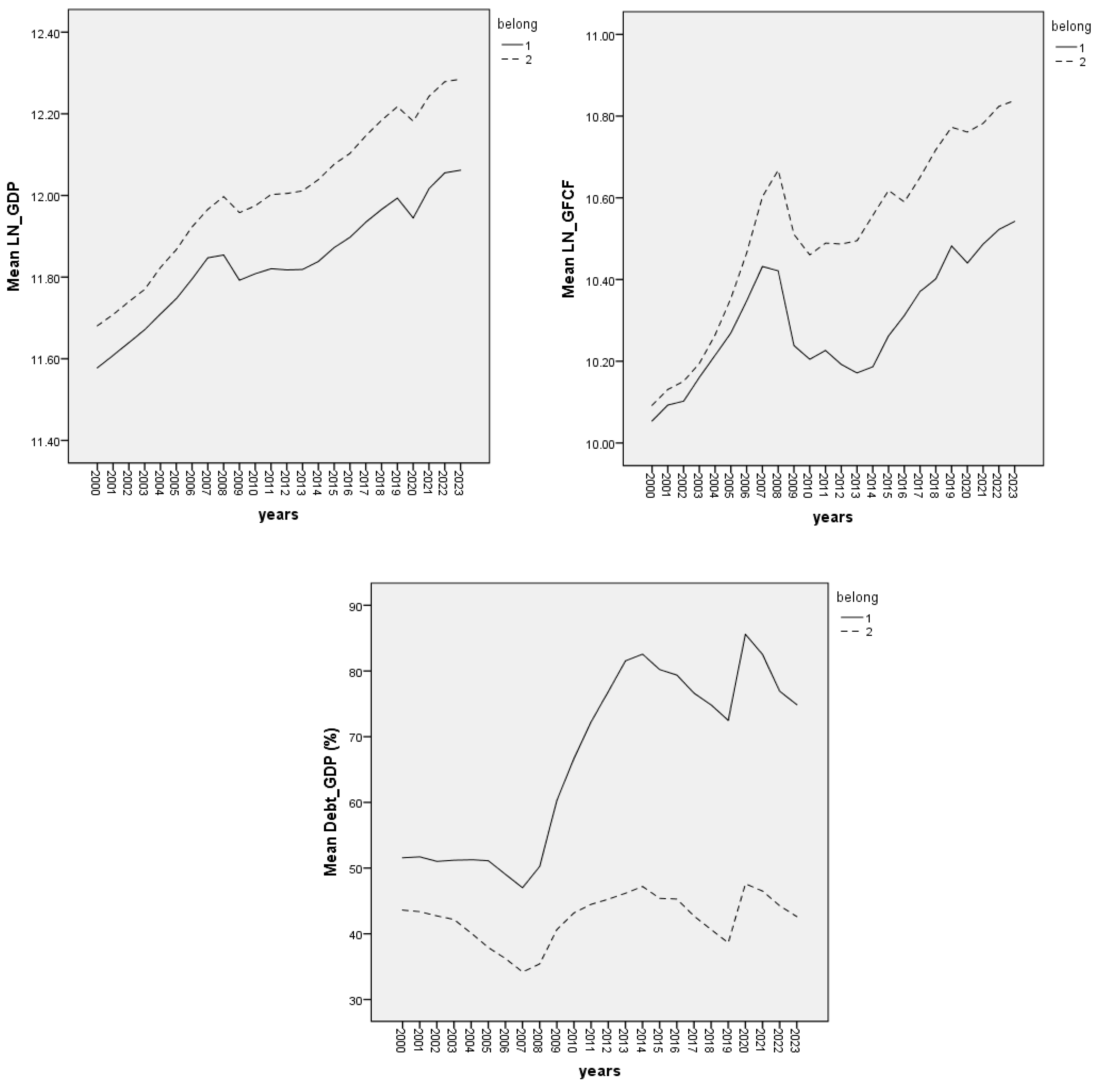4.2.2. Modeling Economic Convergence in Euro Area Countries in the Period of 2000–2023
Economic convergence in EU countries is seen as a common direction of long-term GDP development, as a macroeconomic indicator characterizing the overall development performance of the EU.
All efforts to meet the convergence criteria are reflected in the size of GDP and its dynamics. All convergence criteria are global indicators that have a national level of determination, and the use of GDP instead of GDP per capita provides a better understanding of economic dynamics at the national and macroeconomic level of the EU. We use the logarithmic expression of GDP, denoted LN_GDP, which allows the interpretation of annual changes as its dynamic rates. Price stability ensures a balanced and predictable business environment. More stable exchange rate variations have positive effects on the efficiency of international trade flows, expressed by the international openness indicator, denoted by OPN. The long-term interest rate determines the basic mechanism of investments, expressed by the Gross Fixed Capital Formation indicator, which is used here as a logarithm and denoted by LN_GFCF. The national capital structure, characterized by budgetary constraints, is represented by the debt-to-GDP ratio, denoted as DEBT_GDP.
Considering the intensity and nature of the correlations between the variables LN_GDP and DEBT_GDP, LN_GFCF and OPN, we conclude that the results are similar for both sub-periods, before and after the 2008 economic crisis, as well as for the entire period presented in
Table 10.
During the analyzed period, the GFCF indicator had a very strong and positive correlation with GDP. The debt-to-GDP ratio had a weak and positive correlation with GDP. International openness (OPN) had a weak and negative correlation with GDP, as well as a weak and negative correlation with investment and the debt-to-GDP ratio. In
Figure 13, the evolution of the macroeconomic indicators considered in our econometric approach shows upward trends over the period 2000–2023.
In
Table 11, the Granger causality analysis reveals differences according to the sub-periods 2000–2008 and 2009–2023, and compared to the entire period 2000–2023.
The medium intensity conformity of the long-term interest rate criterion in the three periods, in the euro area (
Table 9), determines LN_GDP to be a Granger cause for LN_GFCF in both sub-periods and over the entire period.
In the first sub-period 2000–2008, the debt-to-GDP ratio was much lower than 60% (
Figure 7, left), and the budget deficit was quite moderate (
Figure 5, left), and no Granger causality was linked to the DEBT_GDP variable. In the second sub-period 2009–2023, OPN is a Granger cause of DEBT_GDP, and DEBT_GDP in turn Granger causes LN_GFCF. The variable LN_GFCF is a Granger cause of OPN.
Only in the entire period, being a sufficiently long period, LN_GDP was a Granger cause for DEBT_GDP, LN_GFCF, and OPN. LN_GDP Granger causes the DEBT_GDP ratio and also LN_GFCF with a p-value less than 5%, but the converse is not true, meaning that the debt/GDP ratio and LN_GFCF do not Granger cause LN_GDP. Furthermore, a dual Granger causality relationship emerges between LN_GFCF and DEBT_GDP.
The variables LN_GDP, DEBT_GDP, LN_GFCF, and OPN are non-stationary, and for each of them, in the period of 2000–2023, a common unit root with individual effects is present for all cross-sections analyzed, but the cross-sections also have their own unit roots.
The variables LN_GDP, OPN, LN_GFCF, and DEBT_GDP are cointegrated only in the period of 2009–2023, according to the Pedroni test of cointegration, with eight out of eleven test statistics rejecting the null hypothesis of lack of cointegration, in
Table A1 (
Appendix A.1); the variables are cointegrated and have a long-run equilibrium.
Since in the two sub-periods the OPN variable acts in the same sense as a Granger cause for LN_GDP, and throughout the period 2000–2023, the cause was reversed, and only LN_GDP is a Granger cause for OPN, we carefully analyze this variable that determines the lack of cointegration in the entire period 2000–2023. After removing it, we find that the remaining variables LN_GDP, DEBT_GDP, and LN_GFCF are cointegrated over the period 2000–2023, based on the Pedroni cointegration test, with eight out of eleven test statistics rejecting the null hypothesis (lack of cointegration) in
Table A2 (
Appendix A.1). The variables LN_GDP, DEBT_GDP, and LN_GFCF are cointegrated for the entire analyzed period 2000–2023, and we will use them in our econometric analysis. Based on Granger causality analysis, in the GDP econometric models, we consider LN_GFCF and the lagged term of DEBT_GDP as explanatory variables.
The economic convergence of the euro area is expressed here by the long-run equilibrium, as resulting from the ARDL models, in
Table A9 and
Table A10 (
Appendix A.2). Another approach is represented by the ECM in
Table A11 for the long-term model,
Table A12 and
Table A13 for the short-term models without and with dummy variables (
Appendix A.2). The results are presented in
Table 12.
The ARDL approach without economic shocks consists of the long-run and short-run models in Equation (5), and, respectively, the corresponding models ARDL with dummy variables for the economic shocks, are in Equation (6).
In
Table 12, the ARDL coefficients in Equations (5) and (6) of the long run equation are significant at Prob. < 1%. The coefficient
of the ECT, in the short-run Equations (5) and (6) is significantly different from 0, negative and less than 1, which attests to the existence of a long-run relationship of the variables; it represents the speed of adjustment towards the long-run equilibrium.
In the long run, a 1 p.p. increase in the lagged debt-to-GDP ratio leads to an average increase of 0.29% in GDP, all other factors remaining constant. A 1% increase in GFCF leads to a 0.5795% increase in GDP, holding all other elements constant. If we take into account economic shocks, a 1 p.p. increase in the lagged debt-to-GDP ratio causes an average increase of 0.33% in GDP, all other factors remaining constant; for every 1% increase in GFCF, GDP increases on average with 0.6134%, keeping all other elements constant. We observe that the coefficients in the long-run ARDL models are significant at a p-value less than 1% and have close values.
In the short run, we observe that in both ARDL models, the coefficient of the DEBT_GDP ratio is not significant; all other variables have significant coefficients at a p-value less than 1%.
The term COINTEQ01 in
Table A9 and
Table A10 (
Appendix A.2) is the Error Correction Term (ECT) in
Table 12 and Equations (5) and (6). ECT contributes on average to the correction towards long-term equilibrium—economic convergence—with a proportion of 19.72%, respectively, 16.43%, if economic shocks are considered separately. ECT represents the speed of short-term adjustment over a one-year period of the panel of euro area countries. The difference between the ECT coefficients of the two ARDL models shows a greater effort in terms of the adjustment speed when the separate influences of economic shocks are not taken into account. We note that, following the 2008 economic crisis, euro area GDP fell by an average of 3.94% in 2009, with other factors remaining constant. In 2020, GDP fell by an average of 6.44% in the euro area economies, all other factors remaining constant. The war between Russia and Ukraine caused an average GDP decline of 1.68% in 2023, ceteris paribus.
The Akaike, Schwarz, and Hannan-Quinn information criteria indicate that the better model is the ARDL with economic shocks. The adjustment speeds for each euro area country, resulting from the ARDL approach with dummy variables, based on the short-run coefficients of their models, over the period 2000–2023, are presented in
Table 13.
Croatia has the highest adjustment speed, at 58.8% over a one-year period, demonstrating its effort to join the Eurozone in 2023. Luxembourg, the Netherlands, and Finland have significant adjustment speeds at a p-value of 5%; all other countries in the group have a significant ECT coefficient at a p-value of less than 1%. Germany and Malta have positive coefficients of ECT. These two countries do not converge towards the long-term equilibrium of the euro area because they do not have a long-run relationship between GDP and the debt-to-GDP ratio and GFCF.
When we consider ARDL without the influences of economic shocks, we find that in France, Italy, and Malta, there is no long-term relationship between the analyzed variables. However, if economic shocks are taken into account, their crisis adaptation policies bring economic growth towards equilibrium in France and Italy, but not in Malta. Economic shocks affected the existence of a long-term relationship between the variables analyzed in Germany, as seen in
Table 13.
The Error Correction Model without dummy variables for economic shocks has the long-term model by the cointegrating regression method and the short-term model in Equation (7) and also in
Table A11 and
Table A12, in
Appendix A.2.
The ECM residuals have a normal distribution as a result of the Jarque–Bera test and respect the assumption that there are no correlations between the cross-sections. The coefficients of the two ECMs from Equations (7) and (8) are presented in
Table 12, comparing them with the coefficients of the two ARDL models.
The coefficients of variables are similar in the two approaches, being smaller in the short term than in the long term, in both. The difference between the short term and the long term is corrected by the ECT with the adjustment speed over a period of one year. In the ECM, the ECT contributes on average to the correction towards the long-term equilibrium of the euro area countries with an adjustment speed of 18.70% over a one-year period, without taking into account economic shocks, and of 16.35% over a one-year period, taking into account the ECM with economic shocks. We observe in
Table 12 very close values of the adjustment speed in both ECM and ARDL, with dummy variables for economic shocks. We consider these models in our analysis.
The evolution of the average level of LN_GDP in the euro area countries and its theoretical values, calculated with the ECM and ARDL model without and with dummy variables, are presented in
Figure 14. The theoretical average values of LN_GDP without dummies for economic shocks are denoted LN_GDPF_ARDL and LN_GDPF_ECM, respectively. The theoretical average values of LN_GDP of the models that take economic shocks into account are denoted ARDL_LN_GDPF and ECM_LN_GDPF, respectively (
Figure 14). The ARDL model is better than the ECM, based on the forecast evaluation indicators in both situations.
Figure 15 shows the evolution of GDP and its long-term economic convergence in the euro area countries over the period 2000–2023, calculated with ARDL and ECM with dummy variables for economic shocks. There are positive and negative deviations of each euro area country’s real GDP from the euro area’s economic convergence. The theoretical values of LN_GDP with the ECM are very close to those in the ARDL model.
The long-term equilibrium of all euro area countries—economic convergence, is checked with the Pedroni test of residuals, which rejects the null hypothesis of absence of cointegration with ten out of eleven test statistics, regarding the cointegration of LN_GDP and theoretical economic convergence, expressed by ARDL_LN_GDPF, in
Table A3 (
Appendix A.1).
The coefficients of the ECT cointegration terms of the ECM and ARDL models, in
Table 12, are negative, less than 1, and significant at a
p-value of 1%, proving the existence of a long-run economic equilibrium in the euro area, which attests to hypothesis H1.
4.2.3. Modeling Economic Convergence in the Non-Euro EU Countries in the Period of 2000–2023
Section 4.1 showed that, thanks to the efforts made, EU countries outside the euro area meet most of the financial convergence criteria, in particular the public debt criterion.
Figure 16 shows the evolution of the variables considered for EU countries outside the euro area over the period 2000–2023. The shocks of the 2008 economic crisis and the 2020 pandemic are evident in the evolution of each variable.
The correlation analysis reveals in
Table 14 the lack of correlation between DEBT_GDP and LN_GDP, which leads to the elimination of this variable from the econometric model. Investments are very strongly and positively correlated with GDP. International openness, OPN, is very weakly and negatively correlated with GDP.
If we do not consider the two developed countries, Denmark and Sweden, the correlations are similar, and there is even a lack of correlation between LN_GDP and OPN. This means that the two excluded countries contributed to international openness more than all other non-euro countries during the period under review.
The Granger causality analysis, in
Table 15, shows that, for non-euro EU countries, DEBT_GDP does not Granger influence any other variable in the period of 2000–2023, and the same happens when excluding Denmark and Sweden. DEBT_GDP is a Granger cause for LN_GFCF in the sub-period 2009–2023 in both situations. According to Granger causality, during the analyzed period, the significant factors for economic development are investment and openness.
We prefer DEBT_GDP and LN_GFCF as explanatory variables of GDP growth, in order to make the comparison with the economic convergence of the euro area. We find the cointegration of the variables LN_GDP, LN_GFCF, and DEBT_GDP for the period 2000–2023 affirmed by six of the eleven test statistics, in
Table A4 (
Appendix A.1).
The Error Correction Model of the LN_GDP, DEBT_GDP, and LN_GFCF variables for the period 2000–2023 has all long-run and short-run equation coefficients significant at Prob. < 1%, as presented in
Table A16 and
Table A17 (
Appendix A.2) and summarized in
Table 16. The residuals of the ECM with significant fixed effects tested for cross-sectional and SUR GLS weights meet the requirements for model validation, of normal distribution and no correlation between cross-sections. The coefficient of determination, R-squared, is 65%. The ECT contributes on average to the correction towards the long-term equilibrium of non-euro countries with an adjustment speed of 9.88% over a one-year period.
The approach of ECM has the following equations of long-run and short-run (9):
When considering the economic shocks, the ECM has the same long-run Equation (9) and the short-run Equation (10) (
Table A18 in
Appendix A.2):
The coefficient of determination, R
2, is close to 69%, better than that of the ECM without economic shocks. The ECM with dummy variables has an adjustment speed of 8.64% over a one-year period towards the long-run equilibrium of countries outside the euro area. If we exclude Denmark and Sweden, the long-run ECM is very close to that of the non-euro EU countries in
Table 16. In this case, the short-run ECM with and without economic shocks does not find significant cross-sectional fixed effects. The ARDL model without economic shocks is not significant in the long run, and the ARDL model with dummy variables for economic shocks has an insignificant ECT coefficient. ARDL models cannot be used due to the small number of cross-sections. We keep all non-euro area EU countries to allow comparisons with the euro area.
The results of ARDL models with and without economic shocks are presented in
Table 16,
Table A14 and
Table A15 (
Appendix A.2), and we see that the coefficients of the long-term ARDL models are significant at Prob. < 1%. The speed of adjustment of ECT from short-term towards the long-term equilibrium is 15.83%, respectively, 12.68% over a one-year period, for the group of EU countries of non-euro area. In
Table 16 we observe similar corresponding values for economic shocks in both the ECM and ARDL models, and smaller than in the case of the euro area.
The short-run ARDL coefficients with dummy variables for each non-euro area EU country over the period 2000–2023 are presented in
Table 17. The countries are in descending order of adjustment speed on short-term to move the system towards the long-term equilibrium. Hungary has the highest speed of adjustment to the long-term equilibrium, at 30.61%. Poland is the only country that has a positive ECT coefficient, indicating the absence of a long-term relationship based on this model. If the ARDL model is used without considering the economic shocks in the period of 2000–2023, all countries in the group have a long-run relationship between the analyzed variables, which means that the ECT coefficients are significant and less than 1. However, considering the separate influence of economic shocks, the speed of adjustment is different for each country and for the entire group.
All the coefficients of the cross-sectional models of the term COINTEQ01, DEBT_GDP(−1), LN_GFCF and the dummy variables are significant at Prob. < 1%. At the level of the group of countries outside the euro area, the coefficient of the lagged term of the variable DEBT_GDP is not significant, but it is significant in the equation of each country; the dummy variable “war” is also significant at Prob. < 1% in the individual model of each country, but not for the group. This difference in significance of the coefficients at the individual and aggregate levels is caused by the unobserved heterogeneity of the countries in the group.
In
Figure 17, the theoretical values of LN_GDP with the ECM and ARDL models with dummy variables represent the economic convergence on the graph of each country and for the group of EU countries outside the euro area. The forecast evaluation indicators show the ARDL model with dummy variables to be better than the ECMs. The coefficients of the ECT cointegration terms for ECM and ARDL models, in
Table 16, are negative, less than 1 and significant at a
p-value < 1%, proving the existence of a long-term economic equilibrium in the EU non-euro area, which attests to hypothesis H2.
4.2.4. Modeling Economic Convergence in EU Countries in the Period of 2000–2023
The variables LN_GDP, DEBT_GDP, and LN_GFCF for all 27 countries of the European Union are cointegrated in the period of 2000–2023. The Pedroni tests reject the null hypothesis of no cointegration with six of eleven statistics, in
Table A6 (
Appendix A.1), both for “no deterministic trend” and for “no deterministic intercept or trend”.
The correlation matrix at the EU level is presented in
Table 18. The correlations between the variables of EU countries are similar to those of the two groups of EU countries: the euro area and the non-euro area.
We test whether a dynamic model is appropriate, and we choose between Difference GMM and System GMM in
Table 19. To identify the appropriate dynamic model for LN_GDP we build the panel data models using the lagged dependent variable as an explanatory variable together with lagged variable DEBT_GDP and LN_GFCF.
In
Table 19, the coefficients
of the lagged dependent variable LN_GDP of the Pool OLS model and the cross-sectional Fixed Effects (FE) model, based on Equation (1), define the upper and lower bounds, respectively, of an interval within which the corresponding coefficient of the lagged dependent variable of the dynamic model is expected to lie.
If the Difference GMM (D-GMM) model has a significant and positive coefficient of the lagged dependent variable
in Equation (12), less than 1, and is comprised within the range bounded by the lower limit by
of the FE model and the upper limit by
of the Pool OLS, then the D-GMM is the best choice.
If the coefficient of the lagged dependent variable of the D-GMM,
in Equation (12) is less than the lower bound of the range, then a system GMM model (S-GMM) can correct this by providing a coefficient of the lagged dependent variable within the established range, as is the case in
Table 19.
The S-GMM model based on the system of the two equations shown in Equation (13) in Eviews is presented in the regression summary in
Table A19 (
Appendix A.2) and in
Table 20. The two Equation (13) contain the instruments associated with the variables: the first equation of the level variables has as instruments the lagged differenced levels of the variables, and in the second equation of the differences in variables, the instruments are the lagged levels of the variables.
All coefficients of the S-GMM model are on short term; in
Table A19 (
Appendix A.2) they are significant at Prob. < 5%. The coefficient c(2) of the lagged variable LN_GDP, in Equation (13), is significantly different from 0, positive, less than 1 and represents the speed of adjustment towards the long-run equilibrium. It is within the range bounded by the corresponding coefficient of the FE model and the Pool OLS model, in
Table 19.
Even if the S-GMM coefficients are on short-term, we consider the economic convergence of the EU, as being the long part of the S-GMM model expressed here by the first Equation (13), presented in
Table 20. The second equation of the system in Equation (13) represents the short-term part of the S-GMM model. Both the theoretical long-run and short-run values of LN_GDP are shown in
Figure 18 and
Figure 19.
The long-run impact of explanatory variables may be separately calculated by dividing the short-run coefficient of each variable to 1 minus the coefficient of the lagged dependent variable, meaning here (1 − C(2)). The Wald test, in
Table 21, shows the values of the long-run coefficients based on the S-GMM model from
Table 20, and affirms that the long-run coefficients are significant at a probability less than 1%.
The cointegration test between LN_GDP and the long part of S-GMM in
Table A7 of
Appendix A.1 rejects the null hypothesis of no cointegration with nine out of eleven test statistics. Cointegration is confirmed for the short-run S-GMM values in
Table A8 (
Appendix A.1) by rejecting the null hypothesis with seven out of eleven test statistics.
The coefficient c(2) of the lagged variable LN_GDP, in
Table 19 and
Table 20, is significantly different from 0, positive, and less than 1, and represents the speed of adjustment towards the long-run equilibrium at the EU level, which attests to hypothesis H3.

